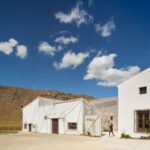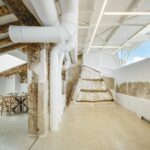Introduction
The Viña Elena Winery, located in Jumilla, Spain, underwent a transformation in 2022 under the guidance of Santa-Cruz Arquitectura. Originally established in 1948, the winery complex, housed in an ancient rural dwelling, was reimagined as a restaurant and wine tourism destination. This rehabilitation project aimed to preserve the historic charm of the buildings while adapting them to contemporary needs.

Unity in Diversity
The project sought to unify the heterogeneous complex, which had evolved over generations, into a cohesive space characterized by unity, design, and spatial quality. Embracing both traditional and contemporary architectural elements, the intervention respected the existing structures while introducing delicate green facades to enhance the complex’s visual appeal.

Heritage Conservation
Heritage archeology played a crucial role in selectively preserving elements of Jumillan architecture that symbolize the region’s rich cultural heritage. Original features such as floorings, furniture, carpentry, and tile cornices were meticulously retained, offering visitors a glimpse into the winery’s storied past. The archaeological excavation in Winery 0 was transformed into a museum, showcasing the facility’s original layout from the last century.

Sustainable Innovations
Addressing the climate emergency, the project incorporated sustainable solutions to enhance energy efficiency, reduce carbon footprint, and promote biodiversity. A green facade system, featuring a steel tube structure adorned with vegetation, not only improves the building’s environmental performance but also creates inviting outdoor spaces for visitors to enjoy.

Structural Enhancements
Preserving the integrity of the original wooden beams, the project reinforced the roofs with new concrete slabs to meet modern structural standards. A technological roof, characterized by a lightweight tree structure, was introduced to facilitate lighting, ventilation, and acoustic conditioning. Additionally, original rooms like the dovecote and garner were repurposed into versatile public spaces, equipped with modern amenities and infrastructure.

Conclusion
The rehabilitation of Viña Elena Winery stands as a testament to the harmonious fusion of heritage conservation and sustainable design. By preserving the essence of the past while embracing the demands of the present, Santa-Cruz Arquitectura has transformed the winery complex into a vibrant cultural destination that honors its legacy while embracing a sustainable future.
















